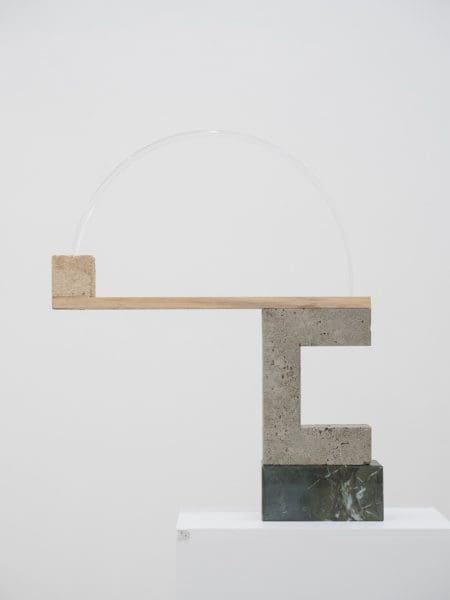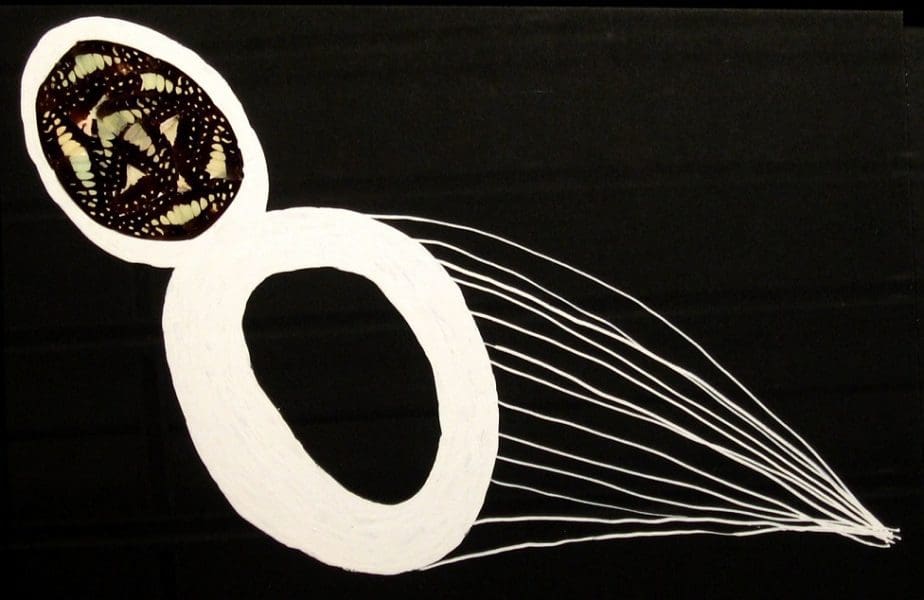
Piercing the veil
A new exhibition at Buxton Contemporary finds a rich complexity in the shadowy terrain between life and death.

Louise Haselton, Asymmetric Engagement, 2016, concrete, acrylic, Perspex and wool, 42 x 20 x 7 cm.

Louise Haselton, End to End 4, 2018, marble, cast concrete, timber and acrylic rod, 72.5 x 61 x 9.5 cm. Private Collection. Photo: Sam Roberts.

Louise Haselton, End to End 1, 2018, marble, acrylic rod, helmet shell, rubber, plastic, 35 x 84 x 37 cm. Photo: Sam Roberts.

Louise Haselton, End to End 2, 2018, timber, mirrored acrylic, acrylic and webbing, 54.5 x 50.5 x 12 cm. Photography by Sam Roberts.

Louise Haselton, Explanatory Gaps, 2014, painted cast bronze, wool, and assorted studio detritus, dimensions variable. Photo: Grant Hancock.

Louise Haselton, untitled #4, 2008, 29 x 42 cm, correction fluid, butterfly wings on board. Private Collection.
Speaking about the title of her show, like cures like, Louise Haselton discusses how she settled on this improbable adage, which is also the principle behind homeopathic treatments. “I was reading about how in the 1500s people believed in the idea of ‘like cures like’. For example, if you had jaundice, and you were yellow, the plumage from the yellow bird could be restorative. I guess in a way that’s what I’m doing in my work. I’m putting these objects together that I feel have similar properties.” Not in order to heal, she continues, “but these objects can have a relationship or a connection, or a transference between each other.” And while “there’s something very satisfying about the thought of ‘like curing like’” she says, there’s also “something quite perverse at the same time.”
With an art career spanning 25 years, Haselton creates sculptures using unexpected materials that land in carefully orchestrated balance. For her exhibition at the Samstag Museum of Art in Adelaide, the artist’s first major show in an institution since a solo exhibition at the Contemporary Art Centre of South Australia in 2011, she has created new works, combined with selected older pieces remade, to continue her exploration of materials.

“Louise is an influential South Australian artist, through the impact of both her practice and her nurturing of the next generation of artists emerging in Adelaide, and it is timely and important to focus attention on her work,” says Gillian Brown, curator at Samstag. “I’m excited by the way that she can summon the sensation of experience, and the way that her work stems from a curiosity as to how much we can know and articulate about that. Spend some time with her works and her deep understanding of her collected materials is clear – she doesn’t look to transform them but to expose them as they are.”
Haselton talks about the objects and materials that she uses to make these works with contagious affection. For like cures like this includes several hundred pairs of denim jeans, an antique tatami mat, mirrored Perspex, rope, a roll of brown paper weighing around 70kg, and a scavenged safety-net barrier that had been hit by a car that Haselton describes as a “pretty magnificent thing with a mangled energy about it.” She cites the Arte Povera group as an influence – “there’s something about the humbleness of their materials, I really like their earthy agrarian references.”
“In this exhibition, I think there’s a sense of the utilitarian,” says Haselton. Featured are materials that were formerly popular in building construction but are now considered sub-par. This includes limestone sourced from a disused quarry in Mount Gambier near her childhood home, which she describes as the starting point for the show. Limestone was used to construct her childhood modernist home by her father, adding personal resonance. The town that Haselton grew up in was in pine country and pinus radiata, native to California and Mexico but considered a weed in Australia, is another building material considered deficient because of its soft qualities. Cast bronze pine cones are among the sculptures included in the show. “The fact that this is the environment that I grew up in and these things being secondary, or poor materials somehow endears them to me,” says Haselton. “I guess I want to give them their dues.”

These objects are brought to the studio where they are subjected to Haselton’s arrangement. “I have an ambivalent relationship to them: I feel quite warmly towards them, but I’m quite comfortable in bending them to my will,” she says. “And I guess I’m quite interested in reanimating and reappraising them – giving them new company and enlivening them.” She cites Constantin Brâncuși, Alexander Calder and Barbara Hepworth as influences. “I’m drawn to the physical object and the way they use their materials and arrange things as well. There’s formal consideration in my works, for sure.” What is particular about her practice is that she achieves a balance of formal composure while maintaining the innate energy of the materials used.
At the end of our interview, Haselton brings up the architect Peter Zumthor. “There’s a book called Atmospheres: Architectural Environments – Surrounding Objects which is a very simple, gorgeous, exploration of what he thinks is successful architecture. It’s about what architecture can produce, can conjure. There’s a segment, and he titles the talk ‘between composure and seduction’, which I think is really interesting. That to me sounds like a balance of composure, or restraint, or poise. And seduction – wanting people to come your way, I suppose, to be with you. The fact that he puts those two things together is really interesting.” Composure, seduction – adding to the liveliness of things – are apt descriptions of Haselton’s practice.
like cures like
Louise Haselton
Samstag Museum of Art
2 August—27 September
This article was originally published in the September/October 2019 print edition of Art Guide Australia.